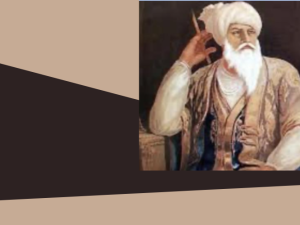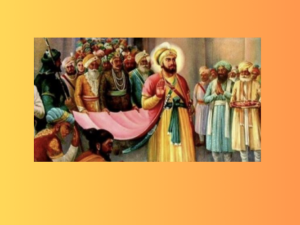AGRA SINGH SETHI
Agra, circa 1784 AD, emerges as a figure of notable historical and literary significance, as elucidated by Dr. Ganda Singh . According to Dr. Singh, there is a plausible assertion that Agra's full name might have been Agra Singh, with 'Agra' serving as his surname. He is identified as a resident of Lahore and a Kshatriya belonging to the Sethi tribe.
Agra Singh Sethi, an eminent poet of the eighteenth century, authored the notable "Veer Haqiqat Rai Dharmi," a composition comprising 212 stanzas. This work poignantly chronicles the life and martyrdom of Haqiqat Rai (1716-1734 AD), who met his end in Lahore during the reign of Nawab Zakaria Khan. The narrative culminates with Haqiqat Rai's martyrdom on Basant Panchami, a fate sealed by the political and religious turmoil of the time.Haqiqat Rai, raised in the home of Bhai Lachchiram, the son of Bhai Kanhai, was profoundly influenced by his uncle Arjan Singh's support for the Singhs residing in the forests. This nurturing environment fostered in Haqiqat Rai a spirit of independence and noble thought, which eventually led him to engage in intellectual debates with Muslim boys at his school. His boldness and refusal to conform drew the ire of the local Qazi of Sialkot, who arrested him and sent him to Lahore, where he embraced martyrdom.
Agra Singh Sethi's "Var Haqiqat Rai" vividly captures the ethos of eighteenth-century Punjab, offering a poignant depiction of the period's socio-political and cultural milieu. Sethi's war poetry, although seemingly straightforward, provides profound insights into the historical context and the resilient spirit of its people. His work, penned fifty years after Haqiqat Rai's martyrdom in 1784 AD, stands as a testament to the enduring legacy of these historical figures and their impact on Punjabi heritage. Agra's poetry is characterized by its simplicity and directness, both in language and narrative. The straightforward diction and unembellished expression serve to enhance the emotional impact of his work, making it an invaluable resource for understanding the socio-cultural and literary landscape of his time.
BAWA SANT RAIN
Bawa Sant Rain (1741-1871 C.E.) was a venerated Udasi sadhu who lived during a period marked by spiritual renaissance in India. Born in 1798 B.C. in Srinagar, Kashmir, to Pandit Harivalabh, a Gaur Brahmin, he was known for his benevolence and philanthropic endeavors. His inclination towards Gurmat Parchar, an adherent of Sikh principles, dedicated himself to disseminating the teachings of the Gurus. Bawa Sant Rain spent the majority of his life in Bhudan (MalerKotla), where he died in 'Samat 1928 B.C.' An erudite scholar proficient in Hindi and Sanskrit, Bawa Sant Rain authored five significant texts in Hindi and Punjabi. These works include "Man Prabodh," "Sri Guru Nanak Vijay," "Sri Guru Nanak Bodh," "Bachan Sangraha," and "Udasi Bodh." Among these, "Sri Guru Nanak Vijay'' stands out as a crucial work detailing the life and teachings of Guru Nanak Dev Ji, while "Sri Udasi Bodh" meticulously documents the history of the Udasi sect.
Bawa Sant Rain's contributions to Punjabi literature are encapsulated in his "Majhs" and "Siharfis," written in Theth Punjabi. These compositions, characterized by their spiritual depth, reflect the profound influence of Gurmat, Sufi, and Udasi ideologies. His works emphasize the importance of relinquishing selfishness and ego to dedicate one's life to the worship of a singular, omnipotent deity. Bawa Sant Rain's poetry, resonant with simplicity and incisive clarity, continues to captivate readers, earning a place alongside the esteemed verses of Hussain and Bulleh Shah.His Gurparnali is as: Sant Rain - Ram Sharan-Mahant Madan Gopal - Mahant Mukat Ram. Through his literary and spiritual legacy, Bawa Sant Rain has left an indelible mark on the cultural and religious tapestry of Punjab, inspiring countless individuals to pursue a path of devotion and self-realization.
SAYEED HASHAM SHAH
Sayeed Hashim Shah, an esteemed Punjabi poet, was born in 1166 Hijri (1752 AD) in Jagdeo village, located in the Amritsar district. He hailed from a humble background, being a carpenter by caste, and was the son of Kasam Shah. Despite his limited formal education, Hashim Shah possessed a natural talent for poetry and quickly gained recognition for his eloquence and profound expression. Hashim Shah's rise to prominence can be attributed to his poetic excellence. His skills caught the attention of Maharaja Ranjit Singh, one of the most significant rulers of the Sikh Empire. The Maharaja's father, Sardar Maha Singh, passed away, and during the mourning period, Hashim Shah recited a "marsia" (elegy) that deeply impressed the Maharaja. This event marked the beginning of Hashim Shah's association with the royal court, where his poetry was highly appreciated.
Maharaja Ranjit Singh had a deep appreciation for poetry and often surrounded himself with talented poets. Hashim Shah's poetry, composed in the Punjabi language, resonated strongly within the court, gaining him gradual but significant recognition. His unique ability to express complex emotions and ideas in a simple, accessible manner made him a favorite among the courtiers and the Maharaja himself. It became a tradition for the Maharaja to invite Hashim Shah to recite poetry during the Dussehra celebrations, where his verses would captivate the audience and bring solace to the ruler. Hashim Shah's poetry belongs to the Fakirana Khyalaat school of thought, which emphasizes mysticism and asceticism. His work is characterized by its simplicity, emotional depth, and the ability to connect with the common people. His verses are filled with passion and fervor, reflecting his God-given gift of eloquence.Through his poetry, Hasham explores complex themes such as the nature of existence, the self, and the ultimate reality. His work continues to be celebrated for its high philosophical content, expressed through everyday language. Hashim Shah, reverently known as Babaji, passed away in 1259 Hijri (1843 AD). According to his will, he was taken to Tharpal, where his tomb still stands today.
Hashim Shah's literary contributions span across various genres and languages, including Punjabi, Persian, and Hindi. He is celebrated for his compositions on diverse themes, such as "Sassi Punnu," "Shireen Farhad," "Sohni Mehinwal," "Heer Ranjha," and "Laila Majnu." Additionally, his miscellaneous works include "Seehaarfis," "Dohda," "Deudha," "Munajat," and "Baramha." His poetic style is characterized by the use of folk-inspired verses and a harmonious blend of Arabic and Persian influences, with his favorite verse form being the Davaiya. His language is noted for its sweetness, simplicity, and naturalness. Hashim Shah played a pioneering role in enriching Punjabi language and literature. He is particularly renowned for his masterpieces "Sassi" and "Dohde-Deudh," through which he demonstrated his ability to craft poignant and beautiful tragedies. His poetry, infused with high fantasy and emotional depth, adeptly conveys themes of pain and love. He excelled in writing concise yet profoundly meaningful poetry, contributing significantly to the literary heritage of Punjab.
HAFIZ BARKHURDAR
Hafiz Barkhurdar, an eminent figure in Punjabi literature, flourished around 1676 AD during the reign of Emperor Aurangzeb. A resident of a Muslim village, Barkhurdar followed the tradition of contemporary storytellers by crafting narratives to entertain the affluent and the noble class. His literary prowess earned him accolades and rewards from notable patrons such as Nawab Jafar Khan. Barkhurdar was also well-versed in Persian, which significantly influenced his works.
Barkhurdar's contributions to Punjabi literature are substantial, with notable works including "Yusuf Zulekhan," "Sassi Punnu," and "Mirza Sahiban." He also composed "Baramah" (Twelve Months), enriching the literary tradition. Kazi Fazal Haq attributes fifteen major works to Hafiz Barkhurdar, including "Tarjuma Qasida Rossia." Hafiz Barkhurdar holds the distinction of being the first to pen the stories of "Yusuf Zulekhan" and "Sassi Punnu" in Punjabi. Additionally, he completed the "Mirza Sahiban" story, initially begun by the poet Pilu, thus advancing its narrative. His writing marked a significant shift in Punjabi Katha-Kavi (narrative poetry), moving away from the Lahindi dialect towards Central Punjabi.Barkhurdar's "Sassi Punnu" and "Mirza Sahiban" were composed in Sad Chhand (a poetic meter), while "Yusuf Zulekhan" was written in Dwaiya (a different metrical form). His works exhibit a palpable Persian influence, reflecting his bilingual proficiency and the cultural intermingling of his time.
NAJABAT
Najabat, an elusive figure from the eighteenth century, is associated with the incomplete poetic work titled "Var Nadir Shah." The extant fragments of this work bear Najabat's name in only two instances, leaving the precise authorship and date of composition shrouded in uncertainty. Bawa Kartar Singh posits that Najabat was a Haral Rajput devoted to Sayyid Shah Charagh, who established Pindi Shah Charagh, now known as Rawalpindi. Singh suggests that Najabat lived in the early nineteenth century, with his descendants currently residing in Matilan Harlan, district Shahpur.
"Var Nadar Shah" is a historical poem chronicling Nader Shah's invasion of 1738-39, culminating in the Battle of Karnal. Contrary to the title, the work predominantly focuses on Punjab, portraying it as the true protagonist. The narrative exudes a profound antipathy towards Nader Shah and vehemently denounces the traitors, as reflected in the scornful verses. This poem stands out for its fervent patriotism and love for Punjab. From a literary perspective, "Var Nadar Shah" is noteworthy, representing an exemplary specimen of Bir-Rasi Var poetry. The verses are marked by eloquence and fervor, with a persuasive narrative, rich metaphors, realistic scene depictions, and vivid imagery. The language is both sweet and evocative, making it a significant literary work of its time.
MIAN KADER YAR
Mian Kader Yar (1802-1850) was a prominent Punjabi poet hailing from Machhike in the Sheikhupura district. He belonged to the Kadyar caste of the Indus Jatt community. His grave, still extant, is located near a distinct round well resembling a fish tank. Despite facing the adversity of orphanhood in his childhood and the consequent inability to receive formal education, his profound desire for knowledge led him to meet a venerable figure who imparted some education to him, eventually enabling him to compose poetry. Kader Yar's works reflect a blend of devotion and patriotism, encapsulating the essence of Punjabi heroism and spirituality. His oeuvre includes notable compositions such as "Chokhi: Puran Bhagat," "Raja Rasalu," "Merajanama," "Rosanna Ma," "Var S: Hari Singh Nalwa," "Puran Bhagat Di Var," and "Kisa Sohni Mehin-Waal." These works highlight not only his narrative prowess but also his ability to infuse his poetry with deep emotional resonance and eloquence.
His magnum opus, "Puran Bhagat," stands as a testament to his poetic genius, earning him enduring respect and affection from both the contemporary government and the Punjabi populace. This work, alongside other renowned narratives like Hashim Shah's "Sassi" and Shah Muhammad's "Jangname," continues to be celebrated for its poignant storytelling and lyrical beauty. Kader Yar employed various poetic forms, utilizing 'bints' in "Puran Bhagat" and "Nalwa," couplets in "Miraj Nama," and couplets in "Sohni Mahiwal." His simple yet evocative narration and articulate speech render his poetry both accessible and profoundly moving.
MIAN MUHAMMAD BAKHSH
Mian Muhammad Bakhsh (1830-1907) was a celebrated Punjabi poet, Sufi mystic, and philosopher, whose literary contributions have profoundly impacted the landscape of Punjabi literature. Born in the village of Khari Sharif, Gujrat district, Punjab (now in Pakistan), Bakhsh's life and works are a testament to the rich cultural and literary heritage of the region.
Bakhsh's poetic oeuvre is characterized by its profound spiritual and mystical themes, reflecting his deep roots in Sufism. His verses are imbued with a sense of love, longing, and devotion, expressing a deep yearning for union with the divine. Through his poetry, Bakhsh explores complex themes such as the nature of existence, the self, and the ultimate reality. Bakhsh's literary style is distinguished by its lyricism, metaphorical richness, and philosophical depth. His use of language is masterful, employing imagery, symbolism, and allegory to convey complex spiritual and philosophical ideas. His poetry is notable for its musicality, with a focus on the sound and rhythm of words, creating a hypnotic effect on the reader. Bakhsh's magnum opus, "Saif-ul-Maluk '' (The Sword of the King), is a masterpiece of Punjabi literature, comprising over 200 poems that showcase his spiritual and philosophical ideas. Bakhsh's poetry has been widely anthologized and studied, with his works influencing generations of poets, scholars, and spiritual seekers. His legacy is a testament to the enduring power of literature to transcend time and touch the human spirit.
Mian Muhammad Bakhsh's contributions to Punjabi literature are a treasured part of the region's cultural legacy, offering insights into the spiritual, literary, and historical landscape of 19th-century Punjab. His poetry remains an eloquent tribute to the enduring power of literature to express the human experience. Bakhsh's poetry has been translated into various languages, including Urdu, Persian, and English, further solidifying his legacy as a celebrated Punjabi poet, Sufi mystic, and philosopher.
SYED SHAH MOHAMMAD
Syed Shah Muhammad (1782-1862) is celebrated as one of the most eminent poets of the Maharaja Ranjit Singh era, often revered as the great national poet of Punjab. His lineage can be traced to Mian Sultan Mahmud of Wadala Veeram in District Amritsar, a member of the Qureshi caste, and a gunner for the Lahore government. Shah Muhammad witnessed firsthand the rise and fall of the Khalsa state, experiences that profoundly influenced his literary work. Shah Muhammad initially composed the narrative of 'Sassi Punnu,' which did not gain significant popularity. However, his subsequent work on the Sikh-British conflict of 1845-46 catapulted him to enduring fame. This composition, known by various titles due to its widespread acclaim, transcends a mere war account. It is a poignant depiction of the political turmoil, struggles for independence, and the eventual subjugation of Punjab following the disintegration of the Shere Punjab regime. Through his verses, Shah Muhammad articulates the collective pain, bravery, and the spirit of the Punjabis, encapsulating their songs of unity, honor, and resilience amidst adversity.
The central theme of Shah Muhammad's magnum opus is an intense patriotism. His narrative exalts Punjab, the Shere Punjab, and its valiant heroes who, despite their strength, succumbed due to a lack of leadership. Shah Muhammad's style is distinguished by its simplicity, free from elaborate metaphors, yet deeply moving and effective. His verses emanate a raw, fervent energy that resonates deeply with readers, leading many to memorize them even today. Employing the sweet, straightforward, and classical dialect of the Majha region, Shah Muhammad significantly enriched the Punjabi lexicon by incorporating widely adopted English and French terms. In composing such a historical and heroic epic in verse, Shah Muhammad pioneered a new literary direction. The social and historical significance of his work surpasses that of his contemporaries, marking it as a pivotal contribution to Punjabi literature and a testament to his literary genius.
BABA HAKAM SINGH DARVESH
Baba Hakam Singh Darvesh, born in Raipur, District Ludhiana, towards the end of the eighteenth century, was the son of Bhai Sahib Bakhsh Ji. His early years saw him enlist in the Khalsa army, where he distinguished himself notably as the fourth-in-command during the Multan campaign, demonstrating exceptional bravery and valor. Renowned for his feats, he earned acclaim from Pir Banke Khan for single-handedly defeating a formidable bear in the jungles of Panja Sahib using only a stick.
Legend holds that Baba Ji fell in love with a woman named 'Fatti', leading to a profound transformation in his life, where love evolved into spiritual devotion ('Ishq Haqiqi'), earning him the epithets 'Ashiq' and 'Darvesh'. He eventually passed away around 1880. His literary contributions include numerous unpublished works such as 'Bairag Haqqani', 'Bachan Ashiq Hakam Singh Ke', 'Jog Kala Seeharfi', 'Bintan Vedanta Gyan Dian', 'Dohde Ishq Haqqani', and 'Chappai Hakam Singh'. These compositions, written in various poetic forms. Baba Ji's language was predominantly Punjabi, with traces of Lehindi and Malvai influences evident in his writing style.
AFZAL MIAN ALLAH BAKHSH PYARA
Afzal Mian Allah Bakhsh, also known by his poetic name "Pyara," was a notable figure in the landscape of Punjabi poetry during the early 19th century. Born in 1215 Hijri (1799 AD) and passing away in 1276 Hijri (1860 AD), he lived during a period of significant cultural and political changes in the Punjab region, especially under Sikh rule. Mian Allah Bakhsh was born in 1799 AD. Little is documented about his early life. Pyara’s contributions to Punjabi poetry were substantial, yet his works are sparsely documented. Only two of his verses have been found, indicating that he did not write extensively or that his works were lost over time. His poetic style and themes, as inferred from his few surviving verses, likely reflected the spiritual and moral ethos of his era. One of Pyara's most significant contributions was the establishment of a madrasa in Lahore during the Sikh rule. This institution, akin to a modern school, became renowned and attracted students from various regions, similar to the educational institutions in Lahore today. The madrasa's influence was significant enough that it is remembered for producing well-educated individuals who likely continued to propagate his teachings and methods.
Pyara's influence is most evident through his disciples. He founded a unique school of Punjabi poetry, and his disciples, scattered across Lahore and Amritsar, testify to his impact. This network of students helped perpetuate his teachings and poetic style, ensuring that his influence extended well beyond his lifetime. Despite his profound impact, the scarcity of Pyara's written work poses a challenge for scholars. The fact that only two of his verses are extant suggests that his poetic legacy was primarily oral or that his writings were not preserved. This oral tradition, however, underscores the importance of his disciples in transmitting his poetic and educational philosophy.
FARID DIN
Farid Din, a distinguished resident of Muzang, emerged as one of the eminent poets during the era of the Sikh Kingdom. During the era of the Khalsa, significant literary and cultural developments emerged, particularly in regions like Muzang. Among the notable figures were Farid Din and Arude Rai, distinguished poets who contributed extensively to both Persian and Punjabi literature. Farid Din, alongside his contemporaries, enriched the poetic landscape with works that reflected the ethos of their time. A pivotal literary work of this period was the "Ranjit Nama," originally composed in Persian, which was later translated into Punjabi by Gulzar Danash, highlighting the cultural exchange and linguistic adaptation prevalent in the Sikh kingdom. These works not only showcased the poetic talent but also served as mediums for cultural expression and historical documentation.
The disciples of prominent figures such as Farid Din and Arude Rai formed vibrant intellectual communities, engaging in poetic dialogues and literary debates that further enriched both Persian and Punjabi literary traditions. These interactions fostered an environment of creativity and scholarly discourse, contributing to the rich tapestry of Sikh cultural heritage.
MIAN HUSSAIN
Mian Hussain.(circa 15th century), also known as Ghulam Hussain, hails from the Chenab region and is renowned for his magnum opus, "Heer Hussain." This work is celebrated for its mellifluous and evocative language. Mian Hussain was a prominent Punjabi poet and Sufi mystic, whose literary contributions have significantly enriched the landscape of Punjabi literature. Mian Hussain's life and works are a testament to the rich cultural and literary heritage of the area. His poetry, replete with vibrant and amorous imagery, often manifests as a veritable garden of love, where the thorns of reality are subtly woven beneath the colorful blooms of verse. The dialogues between lovers in his work are marked by a refined subtlety and a rich satirical undertone, reflecting a unique depth. His portrayal of steadfast love and devotion to the divine illustrates an extraordinary selflessness, capturing the transformative power of true affection. Hussain's return to the Guru-Sikh dynamic underscores his profound spiritual insight, where the trials of love serve as a testament to Ishq's salvific weight.
The poet's words convey an unparalleled poignancy, especially in his depiction of the longing and suffering of separated lovers. His verses, imbued with fervor and intensity, leave an immediate and lasting impact on the reader. Mian Hussain's stature among Punjabi poets is further immortalized by his valor, with a nearby shrine bearing witness to his enduring legacy. This small shrine, adorned with two offerings, invites a deeper exploration of his poetic and spiritual contributions.
MAULVI AHMED YAR
Maulvi Ahmed Yar (1768-1845) was a distinguished poet, eminent scholar, and expert critic of his time. Born into a zamindar family in Islamgarh (District Gujarat), Maulvi Ahmed Yar displayed an early proclivity for reading and writing, which led him to forsake his hereditary occupation in favor of diverse educational pursuits. In his youth, he fell deeply in love with a girl named 'Rani.' The ensuing scandal compelled him to leave his home, eventually leading him to settle in the village of Marala. His scholarly acumen, poetic sensibility, independent rural existence, and the bittersweet experience of unfulfilled love imbued his work with profound emotional intensity. While he composed celebrated traditional love tales such as Heer Ranjha, Sassi Punnu, Sohni Mehinwal, and Laila Majnu, he also innovated within the genre by creating new stories like Chandra Badan, Raj Bibi, and Kam Roop. These contributions enriched Punjabi poetry with fresh narratives. Additionally, he composed chuts (ballads), tafseers (commentaries), war chronicles, and a Shahnama in Persian, detailing the life of Sher-e-Punjab Maharaja Ranjit Singh.
Renowned during his lifetime for his poetic and scholarly endeavors, Maulvi Ahmed Yar enjoyed the patronage of Sikh chiefs and received jagirs in recognition of his work. However, after his death, his prominence waned, unlike his contemporaries Hashim Shah and Kader Yar. This decline can be attributed to the neglect of Punjabi heritage, a lack of innovation in his thematic and formal approaches, and the limited use of Arabic-Persian vocabulary and idioms in his work. Despite these factors, his verse remains pleasing, albeit traditional in style.
MIAN ASHRAF
Mian Ashraf, an eminent ancient Punjabi poet, holds a significant place in the literary history of the Punjab region. Mian Ashraf appears to have been a native of the Jhelum region, one of whose works is famous. The quarrel between Sahti and Jogi (Ranjhe) is written from the story of Heer. Has taken a lesson from Varas Shah, the same content, the same color. Mian Ashraf lived during a time when the Punjab region was a melting pot of diverse cultures, languages, and religious influences. This period saw the synthesis of Persian, Arabic, and local vernaculars, which profoundly influenced Punjabi literature. The region's literature was also shaped by the Bhakti and Sufi movements, which emphasized devotion and mysticism, respectively.
Mian Ashraf's poetry is characterized by its deep spiritual undertones and reflection on human existence. His works often explore themes of love, devotion, and the transient nature of life, resonating with the mystical and philosophical currents of his time. His verses, imbued with lyrical beauty and profound wisdom, have contributed to the rich tapestry of Punjabi literary heritage.
NIHALA
Nihala, also known as Nihal Chand, is a significant figure in the annals of Punjabi literature. His works, though not as extensively documented as those of his contemporaries, have left an indelible mark on the cultural and literary landscape of Punjab. Nihala lived during a time when oral traditions were predominant, and much of the poetic expression was interwoven with the everyday lives of the people, reflecting their joys, sorrows, and the socio-political context of the period. Nihala's poetry emerged during a period when Punjab was a mosaic of various cultures, traditions, and languages. The poet meticulously enumerates the jewels, which remain consistent with those favored during the era of the Sikhs.
The inclusion of deities such as Bhairon, Devi, and Hanuman in the text underscores the poet's Hindu background. This meticulous attention to cultural and religious practices offers a profound glimpse into the historical and societal context of the poet's time. The region was a confluence of influences from Persian, Arabic, and indigenous Indian cultures, which significantly impacted the literary expressions of the time. Nihala's poetry is characterized by its simplicity and depth, employing the vernacular Punjabi language to convey profound philosophical and spiritual insights. His works often explore themes of love, devotion, and the human condition, resonating deeply with the common folk. Unlike some of his contemporaries who might have written in more courtly or scholarly idioms, Nihala's use of everyday language made his poetry accessible and relatable to a broader audience. One of Nihala's significant contributions to Punjabi literature is his role in preserving and promoting the Punjabi language. At a time when Persian was the dominant literary language, Nihala's choice to write in Punjabi was both a political and cultural statement. It underscored the importance of indigenous languages and their role in expressing the collective consciousness of the people. Nihala's poetry often delves into spiritual and philosophical realms, reflecting the Sufi influences that were pervasive in Punjab during his time. His verses frequently explore the mystical dimensions of love and devotion, echoing the sentiments found in the works of other Sufi poets like Bulleh Shah and Waris Shah. Through his poetry, Nihala invites readers to transcend the mundane and seek a deeper connection with the divine.
BABA SAIN DASS
Baba Sain Dass, an ancient Punjabi poet, holds a revered position in the literary and cultural history of Punjab. Baba Saindas was a significant figure among the Gosains in Jammu, Kashmir, and Punjab. He was a contemporary of Guru Nanak Dev, the founder of Sikhism, and was born in 1462 in a Brahmin family. Baba Sain Dass spiritual lineage traces back to Ramanujacharya through Gaddi Ramananda, and his guru parampara includes Ramananda, Anantananda, Ram Das, Sahai Paramananda, Mulk Das, and Saindas himself.The literary style and vocabulary in Baba Sain Dass compositions closely resemble those of Guru Nanak Dev. His verses reflect both the Nirguna (formless) and Saguna (with form) aspects of God, similar to the compositions of Guru Nanak Dev. The original mantra of Baba Saindas encapsulates both these forms, integrating terms like "Nirankar," "Nirvair," "Ajuni," "Akal Murat," and "Murali Manohar."
Baba Sain Dass influence extended beyond his seat in Gujranwala, with preaching centers (akhadas) established in various locations such as Dharamsala (Kangra), Babol (Gujranwala), Sherpur (Dalat Patan), Dhanda (Sialkot), Bal Bawa (Amritsar), Ram Bagh (Srinagar), Fateh pur (Sialkot), Asa Mai (Kabul), and several places in Amritsar and Lahore. His followers continue to be organized, with the Sevak Sangh active in Delhi, particularly in Pul Bangash, Nawan Mahal.
BHAI LACHHI RAM
Bhai Lachhi Ram (circa 15th century) was a Punjabi poet and Sufi mystic, whose literary contributions have significantly enriched the landscape of Punjabi literature. Born in the Punjab region, Bhai Lachhi Ram's life and works are a testament to the rich cultural and literary heritage of the area.Bhai Lachhi Ram's poetic oeuvre is characterized by its profound spiritual and mystical themes, reflecting his deep roots in Sufism. His verses are imbued with a sense of love, longing, and devotion, expressing a deep yearning for union with the divine. Through his poetry, Bhai Lachhi Ram explores complex themes such as the nature of existence, the self, and the ultimate reality. Bhai Lachhi Ram's literary style is distinguished by its lyricism, metaphorical richness, and philosophical depth. His use of language is masterful, employing imagery, symbolism, and allegory to convey complex spiritual and philosophical ideas. His poetry is notable for its musicality, with a focus on the sound and rhythm of words, creating a hypnotic effect on the reader.
Bhai Lachhi Ram's works are also significant for their historical value, providing insights into the social, cultural, and political context of 15th-century Punjab. His poetry reflects the religious and cultural syncretism of the region, showcasing the confluence of Islamic, Sikh, and Hindu traditions. Bhai Lachhi Ram's notable works include "Diwan-i-Bhai Lachhi Ram" (The Poetic Collection of Bhai Lachhi Ram) .Bhai Lachhi Ram's poetry has been widely anthologized and studied, with his works influencing generations of poets, scholars, and spiritual seekers. His legacy is a testament to the enduring power of literature to transcend time and touch the human spirit.
MITHRE DI RANJHA
Mithre Di Ranjha, often referred to as Mithre, is a significant figure in the rich tradition of Punjabi poetry. Emerging from the heartland of Punjab, Mithre's contributions are often celebrated for their lyrical beauty and profound depth. Although precise historical records about Mithre’s life are scant, his work has endured through oral traditions and written compilations, cementing his place among the luminaries of Punjabi literature. Mithre lived during a period when Punjab was a vibrant cultural and intellectual hub. This era witnessed a flourishing of poetic and literary expressions, deeply intertwined with the region’s social, religious, and philosophical milieu. Punjabi poets of this time, including Mithre, were heavily influenced by the Sufi and Bhakti movements, which emphasized devotion, love, and the transcendence of earthly concerns.
Mithre's poetry is characterized by its profound spiritual themes and emotive language. His verses often explore the concepts of divine love, separation (viyog), and the union (milan) with the beloved, which can be interpreted both in a spiritual and a worldly sense. The metaphor of Heer-Ranjha, a classic Punjabi folktale of love and longing, frequently appears in his work. Mithre's influence on Punjabi poetry and culture is profound. His works have been preserved and transmitted through generations, often performed as qisse (epic tales) by itinerant bards and folk singers. This oral tradition has ensured that his poetry remains a living part of Punjabi cultural heritage. Scholars of Punjabi literature often regard Mithre’s poetry as a vital link in the continuum of Sufi and Bhakti literary traditions. His ability to weave complex spiritual ideas into simple, relatable narratives exemplifies the syncretic nature of Punjabi spirituality.
Mithre’s poetry remains a testament to the enduring power of the Punjabi language and its capacity to convey profound spiritual and emotional truths. His legacy, preserved through both written and oral traditions, continues to be a source of inspiration and reflection for scholars, poets, and lovers of Punjabi literature.
(Sources: History of Punjabi Literature, Kalam de Dhanni, Punjabi Sahit Kosh 3vols, A history of Punjabi Literature, Purana Makhio, Babia Bol, Punjabi Vishav Kosh 12 vols, The Encyclopedia of Sikhism, Sant Rain Granthawali ,Mahan Kosh).






